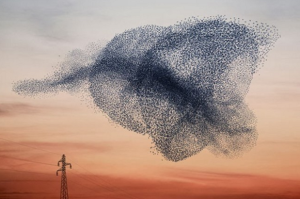 We attempt to interact with one another and arrange our institutions in hierarchical pyramids because we have been taught that the world fundamentally operates according to physical laws that believe that our minds can and should operate in a hierarchical way, with reason directing feeling and instinct. But that thinking doesn’t match up with reality.
We attempt to interact with one another and arrange our institutions in hierarchical pyramids because we have been taught that the world fundamentally operates according to physical laws that believe that our minds can and should operate in a hierarchical way, with reason directing feeling and instinct. But that thinking doesn’t match up with reality.
The hierarchical view of the world only tells part of the story. It is a reflection of the classical physics of the atom: a limited, finite, separate, stable entity that is always precisely identifiable in space and time. But in the 1920s physicist like Niels Bohr discovered that we cannot describe the reality of subatomic—or quantum—particles. These entities are not separate and stable, but random and chaotic. Subatomic particles cannot be precisely identified in space and time except within certain probabilities, and they are entangled in mysterious ways, that Albert Einstein described as “spooky action at a distance.”
To describe reality fully, we need both classical Newtonian physics and quantum physics. Likewise, to understand how our unconscious and conscious minds work, we need to account for instinct and feeling as well as reason, for both chaotic thinking and linear thinking. Even well into the second decade of the twenty-first century, many scientists remain only dimly aware of the implications of quantum physics for the nature of reality, from the makeup of the physical world to the operations of our minds and their creative processes. That doesn’t leave much hope for the rest of us.
The good news is that you don’t need to fully understand the theory to understand how to be successful in our chaotic world. What you do need isIntuitive Intelligence.
Intuitive intelligence is a set of skills I designed that uses intuition to get to the instinctual and nonconscious parts of our minds. It can be learned and developed. But because instinct does not operate in the same way as reason, intuitive intelligence requires unusual forms of learning and thinking. This is why understanding intuition is key.
Intuition doesn’t seek “the truth” or even “sense.” Intuition is completely open to non-sense. It dives down into the depths of the unconscious where reason and instinct collide in unexpected ways, and it latches onto hidden connections and contradictions. Then it brings this information—via an unusual sign, a rare sensation, an unexpected feeling, or a seemingly irrelevant fact—to the surface of consciousness to feed the rational mind and enable logic to work with paradox. Intuition empowers us to operate in the zone of ambiguity and change, the exact place where imagination and genius occur.
Intuitive intelligence helps us survive in new and changing environments by incorporating intuition and instinct into our thought process and our business endeavors. The purpose of instinct is survival. Its ultimate mission is to ensure the sustainability of our species. It understands how to collaborate with and adapt to our ecosystems. This is its inherent wisdom. This is why intuitive intelligence is so needed today.



